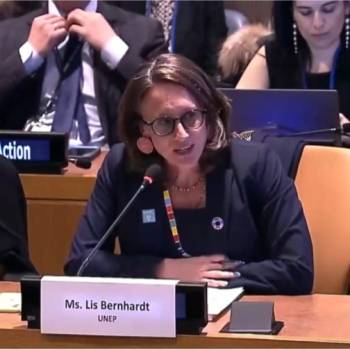
In yet another ominous climate change warning, atmospheric levels of the three main greenhouse gases - carbon dioxide, methane and nitrous oxide all reached new record highs in 2021, according to a new report from the World Meteorological Organization (WMO).
WMO’s Greenhouse Gas Bulletin reported the biggest year-on-year jump in methane concentrations in 2021 since systematic measurements began nearly 40 years ago. The reason for this exceptional increase is not clear, but seems to be a result of both biological and human-induced processes.
The increase in carbon dioxide levels from 2020 to 2021 was larger than the average annual growth rate over the last decade. Measurements from WMO’s Global Atmosphere Watch network stations show that these levels continues to rise in 2022 over the whole globe.
Between 1990 and 2021, the warming effect on our climate (known as radiative forcing) by long-lived greenhouse gases rose by nearly 50%, with carbon dioxide accounting for about 80% of this increase.
Carbon dioxide concentrations in 2021 were 415.7 parts per million (ppm), methane at 1908 parts per billion (ppb) and nitrous oxide at 334.5 ppb. These values constitute, respectively, 149%, 262% and 124% of pre-industrial levels before human activities started disrupting natural equilibrium of these gases in the atmosphere.
“WMO’s Greenhouse Gas Bulletin has underlined, once again, the enormous challenge – and the vital necessity – of urgent action to cut greenhouse gas emissions and prevent global temperatures rising even further in the future,” said WMO Secretary-General Prof. Petteri Taalas.

“The continuing rise in concentrations of the main heat-trapping gases, including the record acceleration in methane levels, shows that we are heading in the wrong direction,” he said.
“There are cost-effective strategies available to tackle methane emissions, especially from the fossil fuel sector, and we should implement these without delay. However, methane has a relatively short lifetime of less than 10 years and so its impact on climate is reversible. As the top and most urgent priority, we have to slash carbon dioxide emissions which are the main driver of climate change and associated extreme weather, and which will affect climate for thousands of years through polar ice loss, ocean warming and sea level rise,” said Prof. Taalas.
“We need to transform our industrial, energy and transport systems and whole way of life. The needed changes are economically affordable and technically possible. Time is running out,” said Prof. Taalas.
WMO UN Climate Change conference, COP27, in Egypt from 7-18 November. On the eve of the conference in Sharm-el-Sheikh it will present its provisional State of the Global Climate 2022 report, which will show how greenhouse gases continue to drive climate change and extreme weather. The years from 2015 to 2021 were the seven warmest on record.
The WMO reports seek to galvanize COP27 negotiators into more ambitious action decision makers to achieve the Paris Agreement goal to limit global warming to well below 2, preferably to 1.5 degrees Celsius, compared to pre-industrial levels. The average global temperature is now more than 1.1°C above the 1850–1900 pre-industrial average.
Given the need to strengthen the greenhouse gas information basis for decisions on climate mitigation efforts, WMO is working with the broader greenhouse gas community to develop a framework for sustained, internationally coordinated global greenhouse gas monitoring, including observing network design and international exchange and use of the resulting observations. It will engage with the broader scientific and international community, in particular regarding land surface and ocean observation and modelling.
WMO measures atmospheric concentrations of greenhouse gases – what remains in the atmosphere after gases are absorbed by sinks like the ocean and biosphere. This is not the same as emissions.
A separate and complementary Emissions Gap Report by UN Environment will be released on 27 October. The Emissions Gap report assesses the latest scientific studies on current and estimated future greenhouse gas emissions. This difference between “where we are likely to be and where we need to be” is known as the emissions gap.
As long as emissions continue, global temperature will continue to rise. Given the long life of CO2, the temperature level already observed will persist for decades even if emissions are rapidly reduced to net zero.
Highlights of the Bulletin
Carbon dioxide (CO2)
Atmospheric carbon dioxide reached 149% of the pre-industrial level in 2021, primarily because of emissions from the combustion of fossil fuels and cement production. Global emissions have rebounded since the COVID-related lockdowns in 2020. Of the total emissions from human activities during the 2011–2020 period, about 48% accumulated in the atmosphere, 26% in the ocean and 29% on land.
There is concern that the ability of land ecosystems and oceans to act as “sinks” may become less effective in future, thus reducing their ability to absorb carbon dioxide and act as a buffer against larger temperature increase. In some parts of the world the transition of the land sink into CO2 source is already happening.


Methane (CH4)
Atmospheric methane is the second largest contributor to climate change and consists of a diverse mix of overlapping sources and sinks, so it is difficult to quantify emissions by source type.
Since 2007, globally-averaged atmospheric methane concentration has been increasing at an accelerating rate. The annual increases in 2020 and 2021 (15 and 18 ppb respectively) are the largest since systematic record began in 1983.
Causes are still being investigated by the global greenhouse gas science community. Analysis indicates that the largest contribution to the renewed increase in methane since 2007 comes from biogenic sources, such as wetlands or rice paddies. It is not yet possible to say if the extreme increases in 2020 an 2021 represent a climate feedback – if it gets warmer, the organic material decomposes faster. If it decomposes in the water (without oxygen) this leads to methane emissions. Thus, if tropical wetlands become wetter and warmer, more emissions are possible.
The dramatic increase might also be because of natural interannual variability. The years 2020 and 2021 saw La Niña events which are associated with increased precipitation in tropics.


Nitrous oxide (N2O)
Nitrous oxide is the third most important greenhouse gas. It is emitted into the atmosphere from both natural sources (approximately 57%) and anthropogenic sources (approximately 43%), including oceans, soils, biomass burning, fertilizer use, and various industrial processes. The increase from 2020 to 2021 was slightly higher than that observed from 2019 to 2020 and higher than the average annual growth rate over the past 10 years


Additionnal notes
The WMO Global Atmosphere Watch Programme coordinates systematic observations and analyses of greenhouse gases (GHG). The Bulletin includes measurement data from 55 WMO Members. This data is archived and distributed by the World Data Centre for Greenhouse Gases (WDCGG) at the Japan Meteorological Agency.
The World Meteorological Organization is the United Nations System’s authoritative voice
on Weather, Climate and Water
Posted on 2022-10-28 08:33








Comments